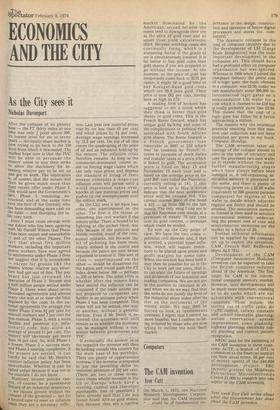The CAM invention
Ivor Catt
On March 1, 1973, the National Research Development Corporation said that the CAM invention " ...could be of fundamental im portance in the design, construction and operation of future digital processors and stores (i.e. computers)."
The dramatic collapse in the cost of computer circuitry due' to the development of LSI (Large Scale Integration) was the most important development in the computer art. This should have had a profound effect on computer organisation but was ignored. Whereas in 1959 when I joined the computer industry the prime cost of a logic gate, the basic element in a computer, was £2.50, today we can manufacture some 300,000 interconnected logic gates on a semiconductor LSI wafer for a cost which is claimed to be £10 but is really probably more like £2.50. This means that the cost of a logic gate has fallen by a factor approaching a million.
The reasons why the enormous potential resulting from this massive cost reduction has not been exploited are given in my book, Computer Worship.
The CAM invention takes advantage of the collapse almost to zero in the cost of circuitry and uses the processed two-inch wafer as it stands without the many further manufacturing stages which 'have always before been indulged in. A self-organising associative memory is generated on the wafer, and there is plenty of computing power on a £2.50 wafer (equivalent to 300 general purpose computers) for regions of the wafer to decide which adjacent regions are faulty and should be avoided. The associative memory so formed is then Used to simulate conventional memory, undercutting the present cost of core and semiconductor memories on the market by a factor of 20.
Further technical information can be supplied by the company set up to exploit the invention, CAM, Crouch Hall, Redbourn, Herts AL3 7EU.
Development of the CAM (Computer Associative Modules) invention can be expected to take the British computer industry ahead of the American. The first target for CAM is the conventional computer memory market.
However, later developments will be much more important, enabling us to do tasks which are not achievable with conventional computers. These include: the sorting out of traffic jams; air traffic control; railway timetable and school timetable planning; airline reservation system improvement; town planning; highway planning; electricity supply planning and control; pattern recognition.
NRDC paid for the patenting of the CAM invention in three countries. ACTP, a branch of DTI, is committed to the financial support (on their usual terms, 50 per cent of money spent) of the £40,000 development project. SRC recently granted the Middlesex Polytechnic Microelectronics Centre £1,000 to research into one aspect of the CAM invention.
Next week Ivor Catt writes about what the Government has done about the CAM invention.


































 Previous page
Previous page